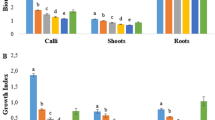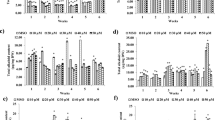Abstract
Ophiorrhiza mungos var. angustifolia is a herbaceous plant distributed in the southern western ghats of India. The species is extensively uprooted for the extraction of high-value anticancer alkaloid camptothecin (CPT), resulting in the eradication of natural population. The present work aims to develop an in vitro protocol for the sustainable production of CPT from callus and cell suspension cultures of the species to conserve the natural resource. Leaf explant excised from in vitro shoot cultures was inoculated onto solid half-strength Murashige and Skoog medium, fortified with auxins like Indole acetic acid (5.71–26.83 µM), Indole butyric acid (4.92–24.6 µM), Naphthalene acetic acid (5.71–28.54 µM), 2,4 Dichlorophenoxyacetic acid (4.52–22.62 µM) and Picloram (4.14–20.70 µM); either individually or in combination with Benzyl adenine, to raise the callus. Of the different combinations of auxins, 10.74 µM Naphthalene acetic acid + 4.44 µM Benzyladenine was selected as the best combination to produce maximum fresh weight of callus. The CPT content of callus was estimated as 0.23 ± 0.03 mg/g DW. Friable calli produced were used to raise cell suspension cultures in half strength MS liquid medium, fortified with different concentrations of auxins. Maximum fresh weight was yielded by a medium supplemented with 16.12 µM Naphthalene acetic acid (14.64 ± 2.03 g). Highest CPT content was estimated in a medium supplemented with 10.74 µM Naphthalene acetic acid as 0.31 ± 0.01 mg/g DW. When compared with the CPT content of field plants, it was found to be higher.


Similar content being viewed by others
References
Bennett RN, Wallsgrove RM (1994) Secondary metabolites in plant defence mechanisms. New Phytol 127(4):617–633
Wink M (2003) Evolution of secondary metabolites from an ecological and molecular phylogenetic perspective. Phytochemistry 64(1):3–19
Lorence A, Nessler CL (2004) Camptothecin, over four decades of surprising findings. Phytochemistry 65(20):2735–2749
Wall ME, Wani M, Cook C, Palmer KH, McPhail AA, Sim G (1966) Plant antitumor agents. I. The isolation and structure of camptothecin, a novel alkaloidal leukemia and tumor inhibitor from camptotheca acuminata1, 2. J Am Chem Soc 88(16):3888–3890
Aiyama R, Nagai H, Nokata K, Shinohara C, Sawada S (1988) A camptothecin derivative from Nothapodytes foetida. Phytochemistry 27(11):3663–3664
Gunasekera SP, Badawi MM, Cordell GA, Farnsworth NR, Chitnis M (1979) Plant anticancer agents X. Isolation of camptothecin and 9-methoxycamptothecin from ervatamia heyneaya. J Nat Prod 42(5):475–477
Arisawa M, Gunasekera S, Cordell G, Farnsworth N (1981) Plant anticancer agents XXI. Constituents of Merrilliodendron megacarpum. Planta Medica 43(12):404–407
Rajan R, Varghese SC, Kurup R, Gopalakrishnan R, Venkataraman R, Satheeshkumar K, Baby S (2013) Search for camptothecin-yielding Ophiorrhiza species from southern Western Ghats in India: a HPTLC-densitometry study. Ind Crops Prod 43:472–476
Deepthi S, Satheeshkumar K (2016) Enhanced camptothecin production induced by elicitors in the cell suspension cultures of Ophiorrhiza mungos Linn. Plant Cell Tissue Organ Cult (PCTOC) 124(3):483–493
Martin KP, Zhang C-L, Hembrom ME, Slater A, Madassery J (2008) Adventitious root induction in Ophiorrhiza prostrata: a tool for the production of camptothecin (an anticancer drug) and rapid propagation. Plant Biotechnol Rep 2(2):163–169
Sudo H, Yamakawa T, Yamazaki M, Aimi N, Saito K (2002) Bioreactor production of camptothecin by hairy root cultures of Ophiorrhiza pumila. Biotechnol Lett 24(5):359–363
Murashige T, Skoog F (1962) A revised medium for rapid growth and bioassays with tobacco tissue cultures. Physiol Plant 15:473–497
Fulzele DP, Satdive RK, Pol B (2001) Growth and production of camptothecin by cell suspension cultures of Nothapodytes foetida. Planta Medica 67(02):150–152
Mathur S, Shekhawat GS (2013) Establishment and characterization of Stevia rebaudiana (Bertoni) cell suspension culture: an in vitro approach for production of stevioside. Acta Physiol Plant 35(3):931–939
Cheng H, Yu L-J, Hu Q-Y, Chen S-C, Sun Y-P (2006) Establishment of callus and cell suspension cultures of Corydalis saxicola Bunting, a rare medicinal plant. Zeitschrift für Naturforschung C 61(3–4):251–256
Wai-Leng L, Lai-Keng C (2004) Establishment of Orthosiphon stamineus cell suspension culture for cell growth. Plant Cell Tissue Organ Cult 78(2):101–106
Sekar T, Ayyanar M, Pillai YJK (2011) Phytochemical screening and antibacterial activity of leaf and callus extracts of Centella asiatica. Bangladesh J Pharmacol 6(1):55–60
Lisowska K, Wysokinska H (2000) In vitro propagation of Catalpa ovata G. Don. Plant Cell Tissue Organ Cult 60(3):171–176
Jisha K (2006) A study on the production of camptothecin from Ophiorrhiza mungos and nolhapodytes foelida using cell and tissue culture, PhD thesis submitted to Mahatma Gandhi Uincersity, Kottayam, Kerala
Duangporn P, Siripong P (2009) Effect of auxin and cytokinin on phyllanthusol A production by callus cultures of Phyllanthus acidus skeels. Am Eurasian J Agric Environ Sci 5:258–263
Nabi SA, Rashid MM, Al-Amin M, Rasul MG (2002) Organogenesis in teasle gourd (Momordica dioica Roxb.). Plant Tiss Cult 12(2):173–180
Tanveer H, Ali S, Asi MR (2012) Appraisal of an important flavonoid, quercetin in callus cultures of Citrullus colocynthis. Int J Agric Biol 14:528–532
Nurazah Z, Radzali M, Syahida A, Maziah M (2009) Effects of plant growth regulators on callus induction from Cananga odorata flower petal explant. Afr J Biotechnol 8(12):2740–2743
Jahan MAA, Hadiuzzaman S (1996) Callus induction and plant regeneration from different explants of Solanum nigrum L. seedlings. Plant Tissue Cult 6:57–62
Chaudhury A, Qu R (2000) Somatic embryogenesis and plant regeneration of turf-type bermudagrass: effect of 6-benzyladenine in callus induction medium. Plant Cell Tissue Organ Cult 60(2):113–120
Shirin F, Hossain M, Kabir M, Roy M, Sarker S (2007) Callus induction and plant regeneration from internodal and leaf explants of four potato (Solanum tuberosum L.) cultivars. World J Agric Sci 3(1):01–06
Karwasara VS, Dixit VK (2013) Culture medium optimization for camptothecin production in cell suspension cultures of Nothapodytes nimmoniana (J. Grah.) Mabberley. Plant Biotechnol Rep 7(3):357–369
Jain R, Sinha A, Jain D, Kachhwaha S, Kothari S (2011) Adventitious shoot regeneration and in vitro biosynthesis of steroidal lactones in Withania coagulans (Stocks) Dunal. Plant Cell Tissue Organ Cult (PCTOC) 105(1):135–140
Acknowledgements
The authors are grateful to the Head, Department of Botany, University of Kerala, for providing them the required facilities to carry out their work.
Author information
Authors and Affiliations
Corresponding author
Ethics declarations
Conflict of interest
The authors have no conflict of interest to publish this manuscript.
Additional information
Significance statement In vitro protocol for production of high value anticancer alkaloid camptothecin from both callus and cell suspension cultures of Ophiorrhiza var. angustifolia were developed. The developed in vitro system could yield double the amount of camptothecin compared with in vivo plants. It helps in conservation of natural population of genus.
Rights and permissions
About this article
Cite this article
Krishnan, J.J., Gangaprasad, A. & Satheeshkumar, K. Biosynthesis of Camptothecin from Callus and Cell Suspension Cultures of Ophiorrhiza mungos L. var. angustifolia (Thw.) Hook. f.. Proc. Natl. Acad. Sci., India, Sect. B Biol. Sci. 89, 893–902 (2019). https://doi.org/10.1007/s40011-018-1003-z
Received:
Revised:
Accepted:
Published:
Issue Date:
DOI: https://doi.org/10.1007/s40011-018-1003-z




